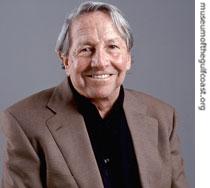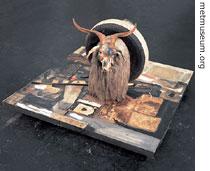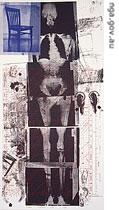-
(单词翻译:双击或拖选)
He was also known for his many projects with other artists. Transcript1 of radio broadcast:
07 June 2008
VOICE ONE:
I’m Steve Ember.
VOICE TWO:
 |
| Robert Rauschenberg |
And I’m Faith Lapidus with People in America in VOA Special English. Today we tell about Robert Rauschenberg. He is widely considered one of the most influential2 artists of the past half-century. Throughout his long career, Rauschenberg explored painting, sculpture, printmaking and even dance performance.
His inventive ideas and bold work made him a revolutionary presence in the art world. One art critic said that there has never been anything in American art to match the energy of Robert Rauschenberg’s imagination.
(MUSIC)
VOICE ONE:
He was born Milton Ernest Rauschenberg in nineteen twenty-five. He grew up in a Christian3 religious family in the small town of Port Arthur, Texas. He studied pharmacology, the science of preparing and using medicine, at the University of Texas for a short time. But he did not complete his degree. He joined the Navy during World War Two in the nineteen forties and worked in hospitals in California. It was there that he saw paintings in an art museum for the first time. Though he had no training, Rauschenberg realized then that he wanted to be an artist.
After the war, he studied art at the Kansas City Art Institute as well as in Paris, France. Rauschenberg changed his first name to Robert because he thought it sounded more like the name of an artist. During this time, Rauschenberg met the artist Susan Weil. They later were married for two years and had a son.
VOICE TWO:
Rauschenberg continued his studies at Black Mountain College in North Carolina. There, he met a group of people who would help redefine modern art and performance. He became good friends with the dance choreographer4 Merce Cunningham and the musician John Cage. He was also influenced by his teacher, the artist Josef Albers. Rauschenberg said that Albers was an impossible person. But he said Albers taught him how to develop his own personal sense of looking. And, this teacher urged students to explore many kinds of materials to make their art.
VOICE ONE:
In nineteen forty-nine, Rauschenberg moved to New York City to be part of its energetic art world. He made a series of all-white paintings. Then, he made a series of all-black paintings. He wanted to explore the way the paintings changed in different lighting5 conditions, or as the shadow of a viewer passed in front of the work.
By the mid6 nineteen fifties, Rauschenberg was making his first “combines," large works of art that were both paintings and sculptures. These experimental works broke down what usually were two very separate art forms. These works included objects such as boxes, books and radios that the artist found in the streets of New York.
The nineteen fifty-five combine called “Bed” became one of his most famous works. It includes a bed sheet, quilt and pillow covered in paint.
VOICE TWO:
 |
| ''Monogram7'' |
The thrown paint on “Bed” was similar to the work of Abstract Expressionist painters like Jackson Pollock who were active at the time. These abstract paintings were meant to show action and color instead of representing a subject matter. But Rauschenberg went beyond Abstract Expressionism by including objects from everyday life in his combines. Later, members of the Pop Art movement would further develop this inclusion of common objects. In nineteen fifty-nine, Rauschenberg made another famous combine, called “Monogram.” This work includes a dead goat with a rubber tire around its middle. The work stands on a painted surface with other "found" objects like part of a shoe and a tennis ball.
VOICE ONE:
Rauschenberg once said that he felt sorry for people who consider things like soap dishes, mirrors or Coke bottles to be ugly. He said these people must be very unhappy because they are surrounded by these objects all day long. Rauschenberg showed in his work that unexpected things can be beautiful if a person takes time to look.
(MUSIC)
VOICE TWO:
Over the years, Robert Rauschenberg continued exploring and combining different forms of art. He developed a method of drawing in which he covered printed images and words in chemicals, then transferred them onto paper using a pencil. He also made boldly inventive lithographs9 that helped bring a new level of respect and attention to the art of printmaking.
 |
| ''Booster'' |
In his nineteen sixty-four work called “Shade,” Rauschenberg combined bookmaking, printmaking and sculpture into one artwork. He printed black and white images onto plastic sheets, which could be placed like pages into a box. A light shining through the sheets made the work into a redefined version of a book. His nineteen sixty-seven print, “Booster,” was at the time the largest hand-pulled lithograph8 ever made. Rauschenberg’s work broke down the boundaries between different artistic10 methods.
VOICE ONE:
By the nineteen sixties, Rauschenberg had become famous in the art world. In nineteen sixty-four he became the first modern American to win the international grand prize at the Venice Biennale art show in Italy. But fame did not cause Rauschenberg to slow down his flow of new ideas. He worked on putting combinations of printed images onto large canvases using screen-printing.
He made many series of other prints, including a "Hoarfrost Series" in nineteen seventy-four. For these works, Rauschenberg printed images onto thin pieces of flowing silk and taffeta fabrics11. And, in his "Cardboard Series," Rauschenberg created interesting wall sculptures using combinations of flattened12 paper boxes.
Robert Rauschenberg once said that he worked in a direction until he knew how to do it, then he stopped. He said that once he became bored or he understood, another question had formed.
(MUSIC)
VOICE TWO:
Robert Rauschenberg strongly believed in working on projects with other artists. In the early nineteen fifties, he worked with his wife, Susan Weil. They made a series of large prints by shining a lamp over a person lying on special blueprint13 paper. He also designed stage sets and costumes for dance productions by Merce Cunningham and other choreographers. He exchanged ideas and worked closely with the artist Jasper Johns. And, he worked with printing experts like Tatyana Grossman in her workshop, Universal Limited Art Editions, in New York.
VOICE ONE:
Rauschenberg helped start a nonprofit group called Experiments in Art and Technology with an engineer from Bell Telephone Laboratories. This group supported joint14 projects by artists and scientists. The idea for the organization came out of a series of nine performances held in nineteen sixty-six in New York City. At these events, engineers and artists combined art and technology in experimental performances.
And, in nineteen eighty-five, he started ROCI which stands for Rauschenberg Overseas Cultural Interchange. Its aim was to find a way to communicate with other countries through the language of art.
Rauschenberg traveled to twenty-two countries including China, Tibet, Uzbekistan, Cuba and the Soviet15 Union. He worked with artists in each country to create pieces of art. They were then exhibited in a museum in that country along with works made in other parts of the world. In nineteen ninety-one, the project ended at the National Gallery of Art in Washington, D.C. with an exhibit of art from each country.
VOICE TWO:
Robert Rauschenberg's work has been in many major museum exhibits. These include shows at the Pompidou Center in Paris, France in nineteen eighty-one and the Guggenheim Museum in New York in nineteen ninety-seven.
In two thousand five, the Metropolitan16 Museum in New York opened an exhibit on Robert Rauschenberg’s combines. His work was also shown at the National Gallery in Washington in two thousand seven.
Later in his career, Rauschenberg started spending more and more time at his home on Captiva Island, off the coast of Florida. There, he had a large studio in which he could work on huge projects. In two thousand two, Rauschenberg suffered a stroke that left him unable to use his right side. He learned to work with his left hand. And, with the help of assistants, he kept making art.
Robert Rauschenberg died in two thousand eight at his home in Florida. He was eighty-two years old. His inventive examples of modern art will continue to influence future generations of artists and art lovers.
(MUSIC)
VOICE ONE:
This program was written and produced by Dana Demange. I’m Steve Ember.
VOICE TWO:
And I’m Faith Lapidus. You can see examples of Robert Rauschenberg's work at our Web site, voaspecialenglish.com. Join us again next week for People in America in VOA Special English.
 收听单词发音
收听单词发音
1
transcript

|
|
| n.抄本,誊本,副本,肄业证书 | |
参考例句: |
|
|
|
2
influential

|
|
| adj.有影响的,有权势的 | |
参考例句: |
|
|
|
3
Christian

|
|
| adj.基督教徒的;n.基督教徒 | |
参考例句: |
|
|
|
4
choreographer

|
|
| n.编舞者 | |
参考例句: |
|
|
|
5
lighting

|
|
| n.照明,光线的明暗,舞台灯光 | |
参考例句: |
|
|
|
6
mid

|
|
| adj.中央的,中间的 | |
参考例句: |
|
|
|
7
monogram

|
|
| n.字母组合 | |
参考例句: |
|
|
|
8
lithograph

|
|
| n.平板印刷,平板画;v.用平版印刷 | |
参考例句: |
|
|
|
9
lithographs

|
|
| n.平版印刷品( lithograph的名词复数 ) | |
参考例句: |
|
|
|
10
artistic

|
|
| adj.艺术(家)的,美术(家)的;善于艺术创作的 | |
参考例句: |
|
|
|
11
fabrics

|
|
| 织物( fabric的名词复数 ); 布; 构造; (建筑物的)结构(如墙、地面、屋顶):质地 | |
参考例句: |
|
|
|
12
flattened

|
|
| [医](水)平扁的,弄平的 | |
参考例句: |
|
|
|
13
blueprint

|
|
| n.蓝图,设计图,计划;vt.制成蓝图,计划 | |
参考例句: |
|
|
|
14
joint

|
|
| adj.联合的,共同的;n.关节,接合处;v.连接,贴合 | |
参考例句: |
|
|
|
15
Soviet

|
|
| adj.苏联的,苏维埃的;n.苏维埃 | |
参考例句: |
|
|
|
16
metropolitan

|
|
| adj.大城市的,大都会的 | |
参考例句: |
|
|
|















